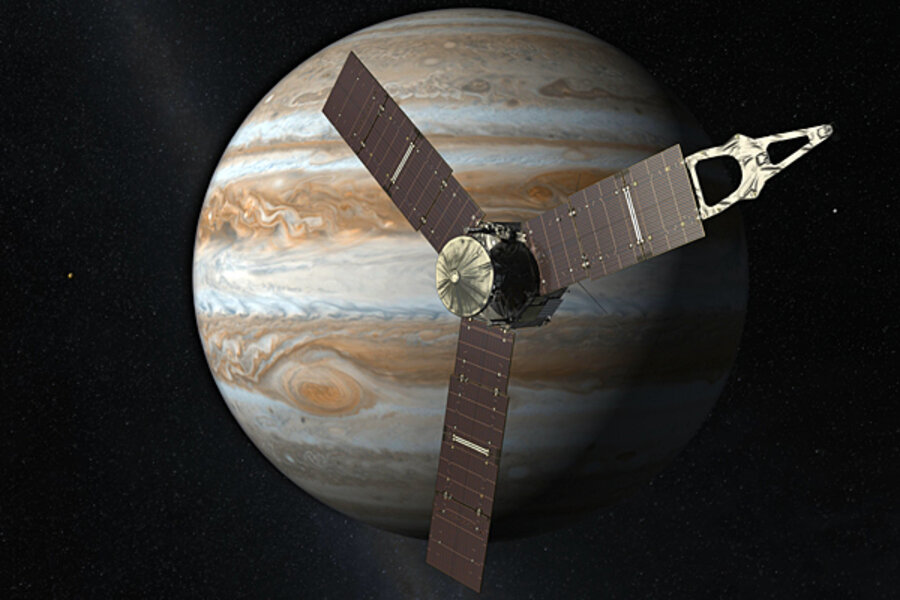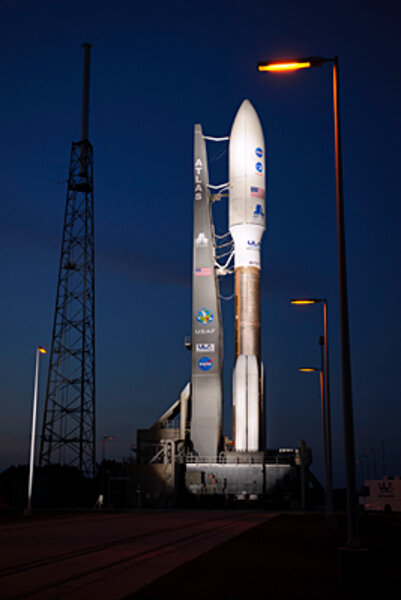What NASA hopes to learn from Juno spacecraft on Jupiter mission
Loading...
Mighty Jupiter once again is on NASA's itinerary.
At 11:35 a.m. Friday, the agency is set to launch an Atlas V rocket topped with spacecraft dubbed Juno, which will embark on a five-year voyage to the giant planet.
Unlike the successful Galileo mission, which toured Jupiter and its moons from 1995 to 2003, the $1.1 billion Juno mission will focus on Jupiter itself. Among the mission's goals: Uncover in unprecedented detail the planet's structure to determine what it reveals about the environment surrounding Jupiter at its birth.
Perhaps more than any other object in the solar system, Jupiter is thought to hold the key to understanding the conditions and constituents that spawned the planets, researchers say.
Like the Incredible Hulk hitting the fridge for a midnight snack, "Jupiter got most of the leftovers" once the sun formed from a collapsing cloud of gas and dust, says Scott Bolton, a planetary scientist with the Southwest Research Institute in San Antonio, Texas, and the mission's lead scientist.
As a result, Jupiter has twice the mass of all of the rest of the planets, asteroids, comets, and other cosmic detritus in the solar system combined – a mass whose gravity profoundly influenced the formation and evolution of the inner solar system.
'Follow the oxygen'
With its enormous gravitational tug holding material in and a vast, powerful magnetic field holding the chemistry-altering solar wind at bay, Jupiter's interior is thought to present a unique, largely unaltered record of the abundance and distribution of elements present when the planets formed nearly 4.6 billion years ago, Dr. Bolton says.
If the mantra for NASA's Mars missions has been "follow the water," for some members of the Juno team the mantra is "follow the oxygen."
Oxygen is the third most abundant element in the universe, after hydrogen and helium. Because the sun and Jupiter formed from the same gas cloud, one might expect the two to have the same relative abundance of oxygen.
Yet "very little has been observed in previous missions" to Jupiter, says Toby Owen, a planetary scientist at the University of Hawaii and a member of the Juno science team.
Researchers say they strongly suspect Jupiter's storehouse of oxygen lies below the striped layer of roiling clouds that envelops the planet. The oxygen probably is bound up in water formed by combining the oxygen with the atmosphere's abundant supply of hydrogen. Using microwave sensors aboard the Juno spacecraft, scientists will in effect peer below Jupiter's clouds and hunt for water and its abundance, from which they can derive the atmosphere's oxygen content.
By observing the ratio of oxygen to three other key elements Jupiter shares with the sun – carbon, nitrogen, and hydrogen – scientists hope to test the model they have of Jupiter's formation, Dr. Owen explains.
If the ratios among the four elements are about the same as the sun's, Jupiter probably would have formed close to its current distance. If, however, ratio of oxygen to these other elements is higher that the sun's, that implies a high water content and a planet that formed farther out from the sun, where ice is more abundant. If the oxygen ratio is lower, it could mean that oxygen combined with silicates in the planet's original parts list, which would then fall and accumulate on what is thought to have been a rocky core tipping the scales at about 10 times Earth's mass.
By taking these microwave measurements at various angles as the craft orbits, scientists also aim to build a detailed vertical profile of Jupiter's atmosphere.
Source of Jupiter's enormous magnetic field?
Another puzzle is the source of the planet's enormous magnetic field – a field some 20,000 times more powerful than Earth's and one that encompasses a volume of space some 100 times larger than that of Jupiter itself. Indeed, Jupiter's moons interact with this field, setting up electrical currents that reach the planet's poles and manifest themselves as bright spots on or near Jupiter's polar aurora.
The magnetic field is thought to be generated by a thick layer of hydrogen – roughly 75 percent of the planet's interior – that, under the planet's tight gravitational squeeze, moves like a fluid but acts like a metal that can conduct electricity. Over the course of Juno's mission, the craft will gather the most complete measurements yet of the planet's field, allowing scientists to tease out the structure of the field and the dynamo that generates it.
Detailed, global measurements of variations in the gravity field will reveal in detail the planet's internal structure by showing how Jupiter's mass is distributed throughout its volume.
A solar-powered venture
All this and more from a craft run off of solar power – the first time a US mission to an outer planet will be operating without plutonium-driven radioisotope thermoelectric generators to provide electricity. Some in the environmental community have protested past missions to the outer solar system out of concerns that an accident at or just after launch could release plutonium into the environment.
Scientists have argued that their destinations are so far from the sun that its radiation is too weak to power their research instruments and the housekeeping electronics to keep the spacecraft operating. But advances in solar-cell technology, combined with newer electronic components that operate on much less electrical current than their predecessors, have allowed the Juno team to operate its orbiter exclusively from sunlight and a pair of hefty batteries.
The Juno craft, hardened to operate in the harsh environment that Jupiter's radiation belts present, sports three solar panels about 8 feet wide and 30 feet long.
When Juno takes up its science orbit – traveling over the poles, instead of along the planet's equator and closing to within 3,100 miles of each pole – it will grab the record for the most distant craft powered by solar energy.






